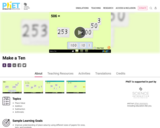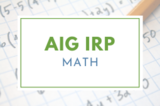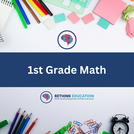
Grade 1 Module 4: Place Value, Comparison, Addition and Subtraction to 40. Contains 29 Lessons.
- Subject:
- Mathematics
- Material Type:
- Module
- Provider:
- EMBARC.Online
- Date Added:
- 08/13/2019

Grade 1 Module 4: Place Value, Comparison, Addition and Subtraction to 40. Contains 29 Lessons.

Grade 1 Module 6: Place Value, Comparison, Addition and Subtraction to 100. Contains 41 Lessons.

Sample Learning Goals
Improve understanding of place value by using different sizes of papers for ones, tens, and hundreds.
Develop mental math strategies when taking apart and putting together numbers.
Use the “make a ten” strategy when counting and doing addition.
Develop a mental model of the basic properties of numbers including commutativity, associativity, and closure.

This document is the About the Cluster document created by the authors of the NC2ML Instructional Frameworks. Read this document prior to teaching the cluster in order to get insight into the clustering of the standards, mathematics to be taught, and important considerations.
This document is not remixable since the document has been written by creators of the NC2ML Instructional Frameworks.

This short video and interactive assessment activity is designed to teach first graders an overview of subtraction (numbers to 100).

Students will observe the base ten representation and choose the correct numeric representation in this interactive.

This is a problem solving worksheet based on helping the environment by planting trees. The problem involves the real-world task of choosing different trees to plant based on cost. Students use strategies to add two digit numbers. This lesson was developed by NCDPI as part of the Academically and/or Intellectually Gifted Instructional Resources Project. This lesson plan has been vetted at the state level for standards alignment, AIG focus, and content accuracy.

Students work in teams to follow criteria and constraints to design their own container that holds pompoms (popcorn). When this is completed they need to test and record how many pom-poms their container will hold. Students find that counting and organizing groups of ten is the best way to do this. They record their information on a data analysis sheet and the following day they compare their numbers and amounts.

In this Khan Academy interactive, students will add a two-digit number and a one-digit number.

This unit was created by the Rethink Education Content Development Team. This course is aligned to the NC Standards for 1st Grade Math.

In this challenging instructional task students relate addition and subtraction problems to money and to situations and goals related to saving money.

Students will use strategies to create 3 addends that equal to 100.

The Family Letters are intended to be sent home at the beginning and middle of the cluster. They explain big ideas of the cluster using family-friendly language. Families can also find tips for working with their children at home, digital games, videos, and books. This file contains both English and Spanish versions of the Family Letters.

This resource is from Tools4NCTeachers.Math games are fun, motivating, and provide opportunities for students to build number concepts, reasoning, and fluency. These games may be used as math stations or as whole group learning opportunities. This file contains directions and materials for Cluster 5 math games.

The intended purpose of this document is to provide teachers with a tool to determine student understanding and suggest instructional moves that may help guide a student forward in their learning. It is not an exhaustive list of strategies.

Players take turns to roll a die and calculate the total of the number rolled plus 10. After each roll the player places a counter on a corresponding number on the board. For example, if a 4 is rolled the player may place a counter on any 14 on the board because 4+10=14. Play continues until one player has 4 counters in a row (horizontally, vertically, or diagonally). Playing board template provided.

In this lesson, students use a card game to add three numbers together then compare them to see who is closest to a target number.